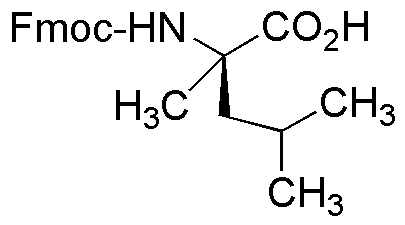Fmoc-a-Me-D-leu-OH is widely utilized in research focused on:
- Peptide Synthesis: This compound serves as a key building block in the synthesis of peptides, particularly in solid-phase peptide synthesis, allowing for the creation of complex and functional peptides.
- Drug Development: It is employed in the pharmaceutical industry to develop peptide-based drugs, offering advantages in specificity and potency compared to traditional small-molecule drugs.
- Bioconjugation: The compound is used in bioconjugation processes, where it helps attach peptides to other biomolecules, enhancing drug delivery systems and targeting capabilities.
- Research in Protein Engineering: Researchers utilize it to modify proteins, which can lead to the development of novel proteins with tailored functions for various applications in biotechnology.
- Diagnostics: Fmoc-a-Me-D-leu-OH is also applied in the creation of diagnostic tools, particularly in assays that require specific peptide interactions, improving accuracy and reliability in medical testing.
General Information
Properties
Safety and Regulations
Applications
Fmoc-a-Me-D-leu-OH is widely utilized in research focused on:
- Peptide Synthesis: This compound serves as a key building block in the synthesis of peptides, particularly in solid-phase peptide synthesis, allowing for the creation of complex and functional peptides.
- Drug Development: It is employed in the pharmaceutical industry to develop peptide-based drugs, offering advantages in specificity and potency compared to traditional small-molecule drugs.
- Bioconjugation: The compound is used in bioconjugation processes, where it helps attach peptides to other biomolecules, enhancing drug delivery systems and targeting capabilities.
- Research in Protein Engineering: Researchers utilize it to modify proteins, which can lead to the development of novel proteins with tailored functions for various applications in biotechnology.
- Diagnostics: Fmoc-a-Me-D-leu-OH is also applied in the creation of diagnostic tools, particularly in assays that require specific peptide interactions, improving accuracy and reliability in medical testing.
Documents
Safety Data Sheets (SDS)
The SDS provides comprehensive safety information on handling, storage, and disposal of the product.
Product Specification (PS)
The PS provides a comprehensive breakdown of the product’s properties, including chemical composition, physical state, purity, and storage requirements. It also details acceptable quality ranges and the product's intended applications.
Certificates of Analysis (COA)
Search for Certificates of Analysis (COA) by entering the products Lot Number. Lot and Batch Numbers can be found on a product’s label following the words ‘Lot’ or ‘Batch’.
Número de catálogo
Número de lote/lote
Certificates Of Origin (COO)
This COO confirms the country where the product was manufactured, and also details the materials and components used in it and whether it is derived from natural, synthetic, or other specific sources. This certificate may be required for customs, trade, and regulatory compliance.
Número de catálogo
Número de lote/lote
Safety Data Sheets (SDS)
The SDS provides comprehensive safety information on handling, storage, and disposal of the product.
DownloadProduct Specification (PS)
The PS provides a comprehensive breakdown of the product’s properties, including chemical composition, physical state, purity, and storage requirements. It also details acceptable quality ranges and the product's intended applications.
DownloadCertificates of Analysis (COA)
Search for Certificates of Analysis (COA) by entering the products Lot Number. Lot and Batch Numbers can be found on a product’s label following the words ‘Lot’ or ‘Batch’.
Número de catálogo
Número de lote/lote
Certificates Of Origin (COO)
This COO confirms the country where the product was manufactured, and also details the materials and components used in it and whether it is derived from natural, synthetic, or other specific sources. This certificate may be required for customs, trade, and regulatory compliance.


